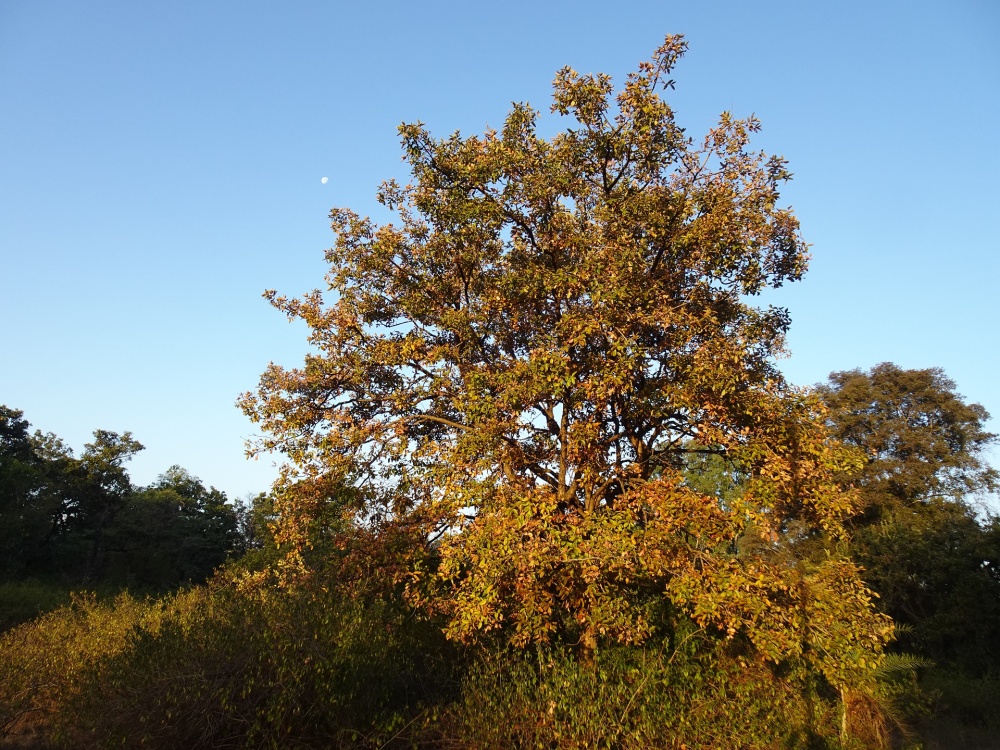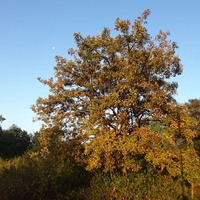Common name: Beleric
Other common names: Bastard myrobalan, Beach almond, Bedda nut tree
Description
Beleric is a timber, medicinal and tanning-yielding tree native to India and Southeast Asia, its natural range extending from India to Malaysia and its distribution within its range scattered across semi-evergreen and deciduous forests.
In closely spaced forests it reaches heights of up to 35 m (115 ft) with a slim, branch-free trunk for most of its height and buttressed roots on large trees. In open spaces it is more commonly 15 to 24 m (50 to 80 ft) tall with a wide-spreading, densely branched rounded crown. The bark is bluish grey, smooth on young trees, developing longitudinal cracks as the tree ages.
The leaves are broadly oval, about 15 cm (6 in ) long, glossy green and crowded toward the ends of the branches. They are semi-evergreen to deciduous, falling off the tree during the dry season to conserve water. The new leaves are bronze-red when they emerge, gradually becoming light green then dark green.
The flowers are small, greenish-white, unpleasant in their aroma and either bisexual or male borne tightly packed on finger-like spikes that arise at the leaf axis. They come into bloom in summer, at around the same time as the new leaves start to grow, which signals the end of the dry season in its native range. They are followed by roundish fruit that mature about five to six months after fruit-set, turning grey-brown with a covering of fine hairs.

Image by Sarangib on Pixabay
Use
Beleric is mostly grown in India as an avenue tree, for its impressive form, attractive foliage and the deep shade it provides.
The wood is medium-weight, averaging 700 kilograms per cubic meter (44 pounds per cubic ft), but with low natural resistance to rot and decay, making it a non-durable hardwood. It is considered a minor timber species, the wood being suitable only for above-ground and indoor construction. The sawn timber is used mainly for interior flooring, manufacturing boxes, and low-value furniture. Selected logs are sliced thinly into sheets for making plywood, and small-diameter logs are pulped for processing into printing, writing and wrapping papers.
The ripe fruit contain around 20% tannin and are dried and used traditionally as a tanning agent in India and commercially to achieve a dark brown colour in fabric and leather products, but is considered inferior to tannin sourced from Black myrobalan (Terminalia chebula).
The fresh leaves are considered a good cattle feed. They have a crude protein content of 9 to 14% of their dry weight.
Oil extracted from the kernels is used to manufacture soap and hair oil.
The flowers are a major nectar source for foraging honeybees in southern India's Indian states of Kerela and Karnataka. However, the honey has an unpleasant flavour, making it unfit for human consumption.
Health use
The fruit contains high levels of tannins that give it astringent properties. In traditional Indian or Ayurveda medicine, the ripe fruit are collected and used in the treatment of diarrhoea and indigestion, and the half-ripe fruit for their purgative and laxative action, due to the presence of an oil with properties similar to that of 'Castor oil' from Ricinus communis.
A gum exuded from the bark, traded as 'Baheda gum' is reportedly utilised in India, most probably as a medicine. It is described as a dark gum, with a smooth, crack-free surface that in water becomes gelatinous and tough, with very little of it dissolving. However, it sometimes contains calcium oxalate, which can contribute to the formation of kidney stones and should be consumed with caution.
Climate
Grows naturally in sub-humid to humid subtropical and tropical lowland to mid-elevation climates, generally in areas with annual lows of 16 to 25°C, annual highs of 26 to 35°C, annual rainfall of 800 to 3300 mm and a dry season of 3 to 8 months. It has its best development in areas with annual rainfall of 1500 mm or more.
Growing
New plants are usually grown from seed. Performs best on free-draining clay and loam soils of a moderately acid to neutral nature, generally with a pH of 5.0 to 7.0, and on sites with full to partial sun exposure.
Problem features
It is listed as a weed in at least one reference publication, but there does not appear to be any record of it anywhere as a serious weed.
The seed kernel is mildly toxic and has a narcotic effect if eaten.
Where it grows
References
Books
-
Asouti, E. & Fuller, D. Q. 2008, Trees and woodlands of South India : archaeological perspective, Left Coast Press, Walnut Creek, California
-
Chevallier, A. 2000, Encyclopedia of herbal medicine, 2nd American ed., Dorling Kindersley, New York
-
Cowen, D. V. 2012, Flowering Trees and Shrubs in India, 6th edition, Thacker Press, Bombay, India
-
Crane, E., Walker, P. & Day, R. 1984, Directory of important world honey sources, International Bee Research Association, London
-
Gohl, B. 1981, Tropical Feeds : feed information summaries and nutritive values (Revised edition), Food and Agriculture Organization of the United Nations (FAO), Rome
-
Green, C. L. 1995, Natural colourants and dyestuffs : a review of production, markets and development potential, Food and Agriculture Organization of the United Nations (FAO), Rome
-
Hocking, D. 1993, Trees for drylands, International Science Publisher, New York
-
Howes, F. N. 1949, Vegetable gums and resins, Chronica Botanica Company, Waltham, Massachusetts
-
Khan, I. A. & Abourashed, E. A. 2010, Leung's encyclopedia of common natural ingredients : used in food, drugs and cosmetics, 3rd edition, Wiley Publishing, Hoboken, New Jersey
-
Krishen, P. 2006, Trees of Delhi : a field guide, Dorling Kindersley Publishers, Delhi
-
Luna, R. K 1996, Plantation trees, International Book Distributors, Dehradun, Uttarakhand
-
Macmillan, H. F. 1943, Tropical planting and gardening : with special reference to Ceylon, 5th ed, Macmillan Publishing, London
-
Nussinovitch, A. 2010, Plant gum exudates of the world : sources, distribution, properties, and applications, CRC Press / Taylor & Francis, Boca Raton, Florida
-
Parrotta, J. A. 2001, Healing plants of peninsular India, CABI Publishing, Wallingford, Oxfordshire
-
Randall, R. P. 2002, A global compendium of weeds, R.G. and F.J. Richardson Press, Melbourne
-
Randall, R. P. 2007, The introduced flora of Australia and its weed status, Cooperative Research Centre for Australian Weed Management, Glen Osmond, South Australia
-
Reyes, G. 1992, Wood densities of tropical tree species, U.S. Department of Agriculture, Forest Service, Southern Forest Experiment Station, New Orleans, Louisiana
-
Scheffer, T. C & Morrell, J. J. 1998, Natural durability of wood : a worldwide checklist of species, Forest Research Laboratory, Oregon State University, Corvallis, Oregon
-
Sheikh M. I. 1993, Trees of Pakistan, USAID Forestry Planning and Development Project, Pictorial Printers, Islamabad
-
Troup, R.S. & Joshi, H. B. 1975 to 1981, Silviculture of Indian Trees (3 volumes), Government of India Publications, New Delhi
-
Wulijarni-Soetjipto, N. & Lemmens, R. H. M. J & 1991, Dye and tannin-producing plants, Prosea Project, Pudoc, Wageningen, The Netherlands
Articles, Journals, Reports and Working Papers
-
Dagar, J. C. & Singh, G. 2007, Biodiversity of Saline and Waterlogged Environments: Documentation, Utilization and Management, NBA Scientific Bulletin, (9), 78.
-
Singh, K. P. & Kushwaha, C. P. 2006, Diversity of flowering and fruiting phenology of trees in a tropical deciduous forest in India, Oxford University Press

.5858.thumb.jpg)

